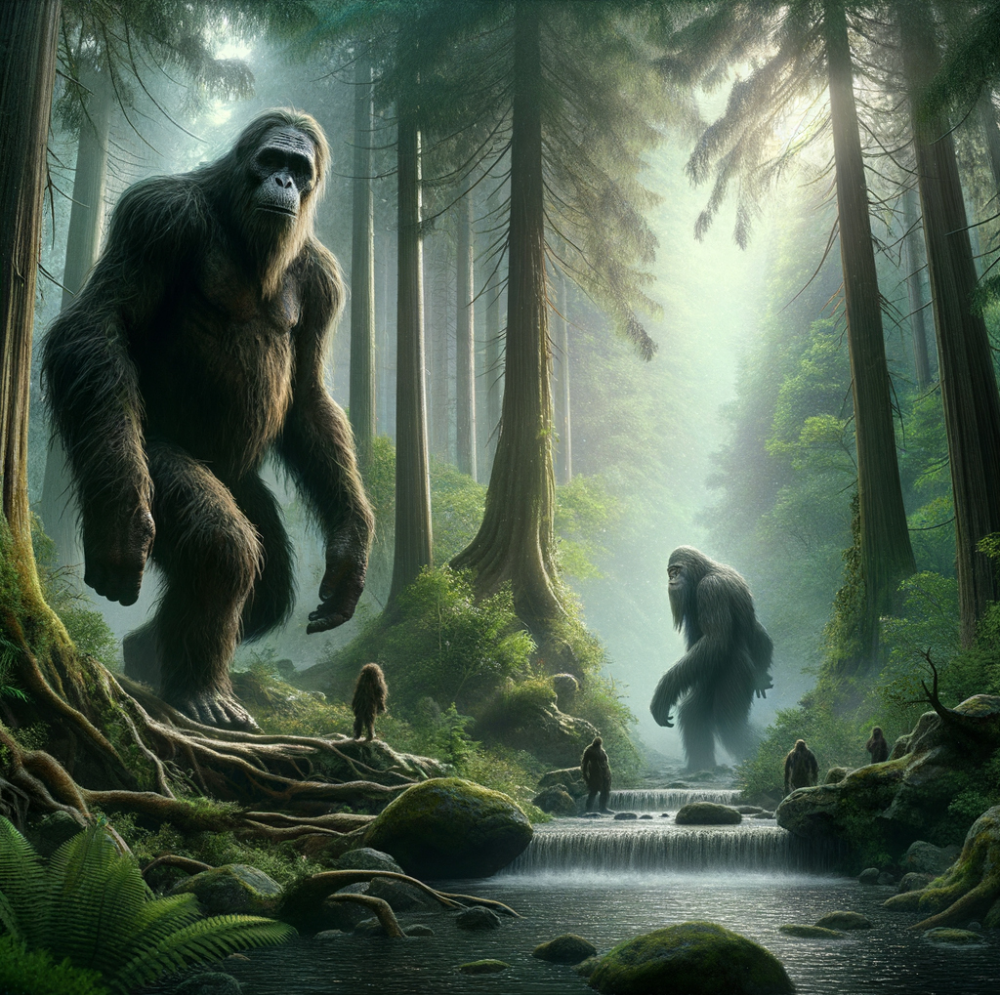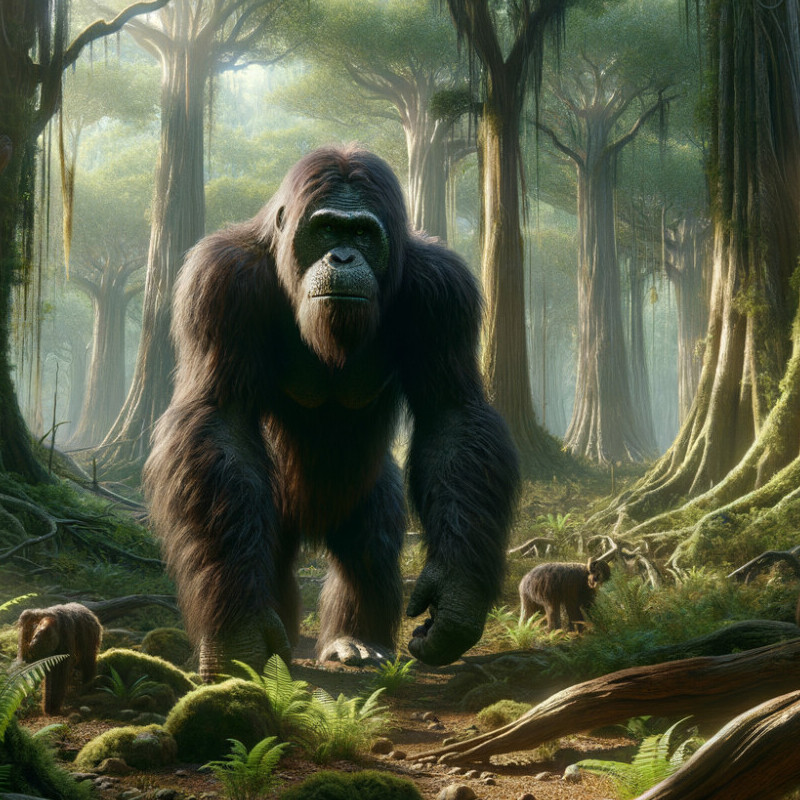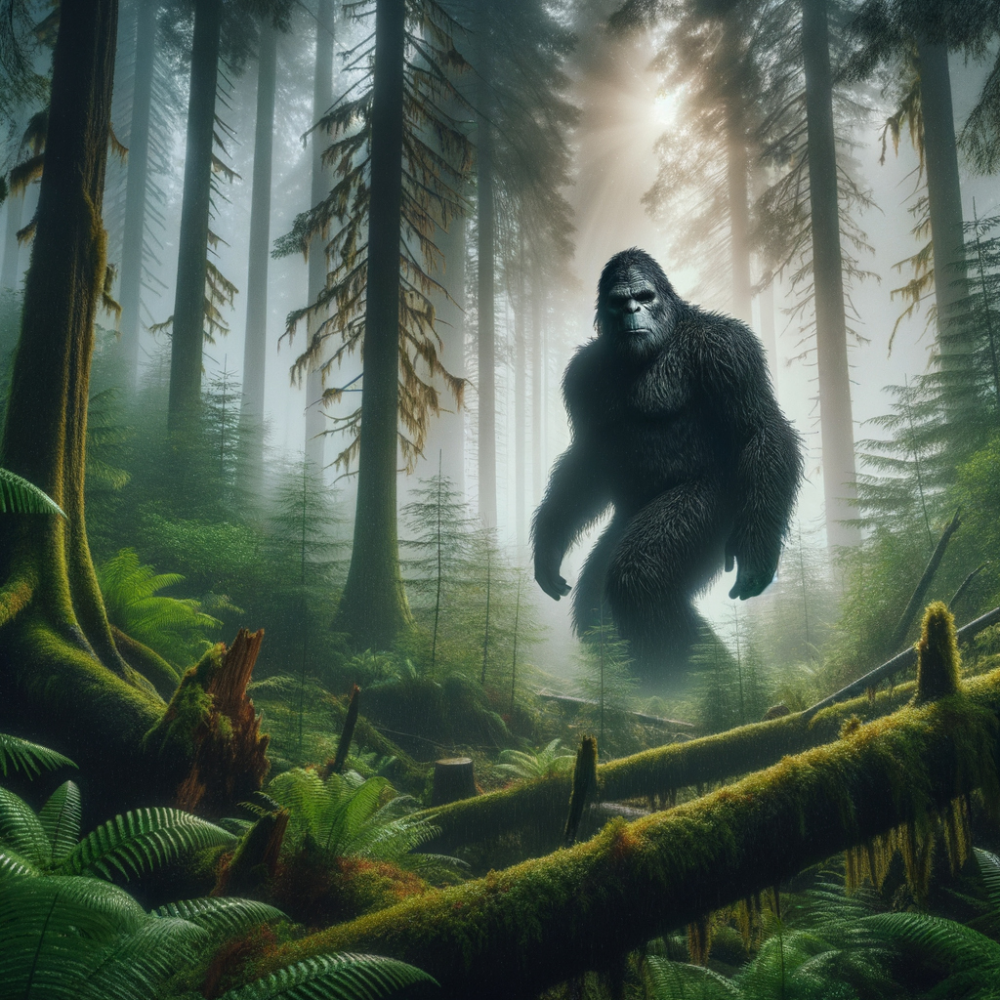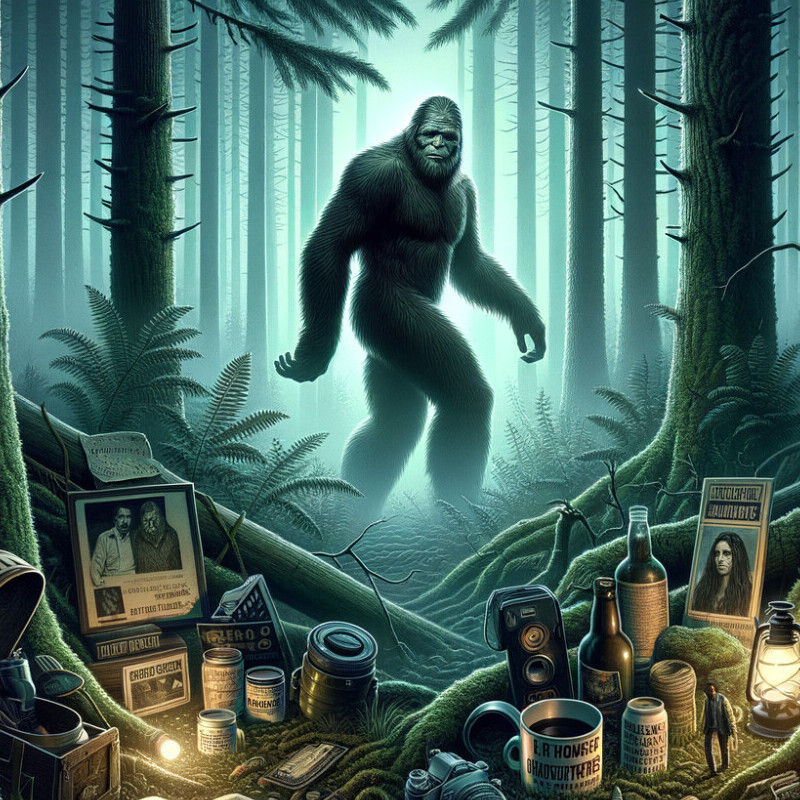Gigantopithecus And Bigfoot: Are They Related?
Gigantopithecus and Bigfoot are two names
That often spark curiosity and a bit of skepticism. One belongs firmly to the world of paleontology, while the other resides in the realm of folklore and cryptozoology. While they might seem worlds apart, there’s a fascinating conversation to be had about their potential (though highly debatable) connection.
FULL DISCLOSURE:
All of my posts on my website do contain affiliate links. They will lead you to other helpful blogs i have written about Bigfoot gear & Stories. There are also Amazon Products links on this Blog. So If you do click on any link it will lead you to that product if you do make a purchase,
As an Amazon Associate I earn from qualifying purchases. It is also at no additional cost to you to explore these links. Have a look at these great books !!
- Bushcraft 101: A Field Guide to the Art of Wilderness Survival
- Bushcraft (6 books) Kindle edition
- Edible and Medicinal Plants of Canada
is a real genus of apes, known from fossil evidence discovered in Asia. These giant apes roamed the Earth over 300,000 years ago, capturing the imagination of scientists and laypeople alike. Imagine a primate towering up to 10 feet tall, weighing around 1,100 pounds! It’s like something out of a prehistoric fantasy, but this time, it’s grounded in fossil reality.
On the flip side, Bigfoot (or Sasquatch)
is a legendary creature said to inhabit forests, primarily in North America. Descriptions usually paint a picture of a large, hairy, bipedal humanoid. Despite innumerable ‘sightings’ and some mysterious footprints, concrete evidence remains elusive. Yet, the legend of Bigfoot endures, fueled by anecdotal accounts and a hefty dose of pop culture.
This intriguing juxtaposition raises fascinating questions.
Could these sightings be remnants of an ancient memory embedded in human consciousness?
Or is it merely the human penchant for storytelling at play?
As we navigate through this article, we’ll explore the realms of science and legend to see if there are any bridges that connect the gigantic fossils of Gigantopithecus with the elusive figure of Bigfoot.
Gigantopithecus: The Prehistoric Giant Ape
First discovered through fossil evidence in Asia, Gigantopithecus has been a point of fascination for paleontologists. These massive apes lived during the Pleistocene epoch, with their time on Earth dating back over 100,000 years. Fossil records, primarily teeth and jawbones, give us a glimpse into their impressive size and characteristics.
Gigantopithecus was no ordinary ape.
Their physical traits were striking. These giants could reach up to 10 feet in height and weigh around 1,100 pounds. That’s like a combination of an orangutan and a gorilla but super-sized. Their large molars and thick jaws suggest they had a diet predominantly made up of plants, particularly bamboo. Yes, folks, think of them as gigantic bamboo munching machines.
Their primary habitat stretched across what is now modern-day China, India, and Vietnam. Dense forests and jungles provided the perfect sanctuary for these giants to roam and feed. With their massive size, they likely had few predators but faced competition for food, which might have contributed to their extinction.
While we don’t have full skeletons, the fossilized teeth and jaws of Gigantopithecus give us insights. These fossils hint at an animal perfectly adapted to its environment but may have failed to adapt to changing climates and habitats. The discovery of Gigantopithecus makes us wonder what other giants once tread the Earth
Exploring Bigfoot To The Yeti & Cousins
.
Bigfoot: The Legend and Sightings
Bigfoot, also known as Sasquatch, is an iconic figure in North American folklore. Descriptions tend to paint a picture of a large, hairy, bipedal creature resembling an ape. Despite countless eyewitness accounts, credible physical evidence remains frustratingly elusive. Nonetheless, the legend persists, capturing the imaginations of many across the globe.
Here is a interesting blog on :
The Origins Of Sasquatch Lore: How Myths And Legends Evolved
Historical sightings of Bigfoot
go back centuries, with indigenous tales and early settler reports describing encounters with mysterious hairy giants. These age-old stories contribute to the rich tapestry of the Bigfoot saga, blending myth and reality in a way that keeps people fascinated.
Reports of Bigfoot sightings are predominantly concentrated in forested regions of the Pacific Northwest, but stories span across North America. The dense, remote woodlands seem to be the perfect hideout, enabling Bigfoot to maintain its elusive status. From the dense forests of Washington State to the rugged terrain of British Columbia, sightings have kept the legend alive.
Here is a interesting blog on:
Bigfoot Sightings: Fact Or Fiction?
In recent years, modern-day Bigfoot hunting and research have turned into somewhat of a cult phenomenon. Enthusiasts equipped with the latest technology set out into the wild, hoping to catch a glimpse or capture evidence of this legendary creature. These expeditions are fueled by a mix of belief in the unknown and the thrill of adventure.
Analyzing the Connection: Scientific Perspectives
Some scientists and enthusiasts have tried to link Gigantopithecus with Bigfoot by suggesting that the giant ape might have survived extinction and continued to roam the forests of North America. Sounds thrilling, right?
Yet, the scientific community remains skeptical.
One theory posits that Gigantopithecus, or its descendants, somehow crossed the Bering Land Bridge from Asia to North America. Once here, it’s assumed they’d adapt over millennia, leading to the Bigfoot sightings reported today. Exciting as it sounds, there are gaps in this hypothesis, notably the lack of physical evidence like bones or definitive DNA samples.
Scientific Explanations For Sasquatch Myths: What Do Experts Say?
Comparative anatomy adds another layer to this discussion. When you place the skeletal reconstructions and fossil records of Gigantopithecus alongside Bigfoot descriptions, some similarities do emerge.
Both are emblematic of giant, bipedal primates. However, Gigantopithecus primarily moved on all fours, unlike Bigfoot, which is said to walk upright. These distinctions fuel scientific skepticism.
Skeptics argue that
Bigfoot sightings are more likely the result of misidentification, hoaxes, or psychological phenomena rather than encounters with a surviving population of giant prehistoric apes. The lack of credible evidence remains a significant hurdle for proponents of a Gigantopithecus-Bigfoot connection.
Despite the scientific critiques, the allure of connecting these two giants of legend and prehistory remains irresistible to many. The hunt for definitive proof continues, blending the thrill of discovery with the mystery of the unknown.
The Cultural and Psychological Aspect of Bigfoot
Bigfoot isn’t just a mythical creature; it’s a cultural icon. From movies to merchandise, Bigfoot has become a staple in popular culture. The creature’s elusiveness only adds to its mystique, making it an enduring symbol of the unknown and the undiscovered.
In folklore,
Bigfoot encapsulates the human fascination with monsters and the wilderness. Tales of large, hairy creatures in the woods can be found in indigenous cultures long before the term ‘Bigfoot’ became popular. This cultural tableau keeps the legend alive and evolving.
Psychologically, Bigfoot sightings
Can often be explained by pareidolia, the tendency to see familiar shapes in random structures. When someone catches a fleeting glimpse of a figure in the woods, the brain might fill in the gaps to resemble Bigfoot. Stress, fear, and isolation can amplify these perceptions, making a bear or a tree stump appear as something far more intriguing.
Bigfoot Stories Passed Down Through Generations In Canada
The media plays a big role in perpetuating the Bigfoot myth.
Television shows, documentaries, and social media channels dedicated to Bigfoot hunting fuel public interest. These platforms often present anecdotal evidence and grainy footage, which stokes curiosity while rarely offering concrete proof.
Despite the skepticism and lack of hard evidence, the cultural phenomenon of Bigfoot continues unabated. The creature symbolizes the eternal human curiosity and the allure of the unexplored. Whether or not Bigfoot exists in a biological sense, it certainly lives on in the collective imagination.
How To Differentiate A Bigfoot Hoax From A Genuine Encounter
Conclusion: Are Gigantopithecus and Bigfoot Related?
So, after exploring the fascinating world of Gigantopithecus and Bigfoot,
Are these two massive figures of prehistoric and folklore origin connected?
The scientific evidence leans heavily against this possibility. While the idea of a living Gigantopithecus morphing into the Bigfoot legend is captivating, it’s more rooted in imaginative speculation than hard facts.
Fossils and scientific data provide a clearer picture of Gigantopithecus as a giant ape that lived in Asia, primarily on a plant-based diet, and moved largely on all fours.
On the other hand, Bigfoot sightings are shrouded in anecdotal evidence, cultural tales, and psychological phenomena. The two don’t quite fit together neatly in the puzzle of reality.
Yet, the allure and mystery surrounding both remain irresistible. Gigantopithecus offers a tantalizing glimpse into a world long gone,
Debunking Popular Sasquatch Myths: Separating Fact From Fiction
showing us the scale and diversity of prehistoric life. Bigfoot, as a modern-day legend, taps into our love for mystery and the unexplored. Both serve as reminders of the vast unknowns that still exist, whether in our fossil records or the dense forests of North America.
While a biological connection between Gigantopithecus and Bigfoot may be far-fetched, the curiosity and excitement they generate are very real.
Bigfoot Legends And Folklore
They both compel us to keep exploring, questioning, and imagining. And in that sense, they are absolutely related—as symbols of our relentless quest for knowledge and adventure.
Thank you for taking the time to read my blog! I hope you enjoyed it!
Here is a sneak peak on a new mystical creature : will be posted next Sunday








I love the whole fascination with Bigfoot and said sightings of an upright ape like creature walking around. I wouldn’t want my kids to read this, but I personally lean on the side of the sightings being the result of misidentification or a hoax, as mentioned in your article. I’ve always taken my kids “Bigfoot hunting” when we are in areas of forest, and have them fully convinced that I am a true believer and really hope to spot a Bigfoot some day. Your comparison of the ancient skeletal evidence of the Gigantopithecus and Bigfoot are interesting, but its hard to believe a Gigantopithecus from Asia, ended up in Lake Tahoe, Oregon or Washington.
Hi Mike,
Thanks for the great comment, just for the record i don’t believe that you just believe in Bigfoot around your kids! i believe deep down inside there is a true believer but that cool you do you bud . But You know that is the best part about Bigfoot hunting The believing part is where all the excitement comes from at the thrill of the hunt. Well i’m a big believer for sure, but i do agree with you that Gigantopithecus from Asia, Didn’t end up in Lake Tahoe, Oregon or Washington.
But i do think if Asia had one why couldn’t the Us/Can have one too. i do believe that there could be a large prime-mate that may live deep in the wilderness. maybe one day we will find that out.
we get all these images,video footage and yes some you can tell they are made up 100% but i’m talking about the people that really had the encounter that caught it on tape, or have you ever talked to some one that has had encounter, Hear the passion in there voice,or see there eyes well their telling the story. i see the belief there for sure.
thanks again for the great comment and i truly hope one day your out there you really do see something best of luck pal
You did an excellent job of exploring the similarities between the two, especially the way you described the possible link based on fossil evidence and folklore. It’s clear you’ve put a lot of thought into the subject. One thing I’m curious about: do you personally lean more toward the idea that Bigfoot could be a descendant of Gigantopithecus, or do you think it’s just a fun myth? I’d love to hear your take!
Hi Bob,
Thanks for the awesome comment, Yes i have a bit of time in my blogs! and i enjoy writing them . for you question
Do you personally lean more toward the idea that Bigfoot could be a descendant of Gigantopithecus, or do you think it’s just a fun myth?
No I just thought this would be a fun article to write . i don’t believe that Bigfoot is a descendant of Gigantopithecus Now i do believe that we may have a large ape-like primate of our own leaking in the deep wilderness.
thanks for following along with the articles i’m glad you enjoyed them.
Wow! This is very nice post. I’ve always been fascinated by the idea of Bigfoot and the possible connection to Gigantopithecus. It’s wild to think that a creature as massive as Gigantopithecus once roamed the Earth, and I can’t help but wonder if stories of Bigfoot are somehow rooted in ancient memories of these giant apes. While it’s probably more fantasy than fact, there’s something fun about entertaining the possibility that maybe, just maybe, we’ve yet to discover everything hiding in the wilderness.
That said, I lean more toward the idea that Bigfoot legends are a mix of folklore and our natural tendency to fill in the gaps when we encounter something unfamiliar. I’ve been on plenty of hikes where the shadows or noises in the woods made my imagination run wild! What do you think—could Bigfoot be a distant echo of Gigantopithecus, or is it purely a product of human storytelling?
Hi Macfais9,
Thanks for the great comment,
No I just thought this would be a fun article to write . i don’t believe that Bigfoot is a descendant of Gigantopithecus.
But i do believe that we may have a large ape-like primate of our own leaking in the deep wilderness. so if there was an Gigantopithecus that was real.Then why couldn’t there be one here in north america.
Bigfoot is filled with lots of mystery like : People reports , Footprints, Structures found in the wilderness, loud hows been recorded, With lots of video & imaging.
Now i DO believe that there has to be something out there because if there not why would all these people report things that are not there that’s the question i’m looking for ?
and if it’s for the 5 min of fame Now i find that hard to believe lol. but the truth always comes out one way or another. Only time will tell.
thanks for the great comment,